Analysis of Management in Tesco: Styles, Change, and Communication
VerifiedAdded on 2021/02/20
|9
|2097
|42
Report
AI Summary
This report provides a detailed analysis of management practices within Tesco, a British multinational retailer. It begins by evaluating the meaning and purpose of management at senior, middle, and junior levels, outlining the hierarchical structure and responsibilities at each level. The report then explores different management styles, including directive, autocratic, and democratic approaches, assessing their potential impacts on the organization. The analysis further examines the reasons for organizational change, such as technological advancements and market pressures, and evaluates strategies for managing these changes, including the use of Lewin's change model. The importance of effective communication within management, in relation to decision-making, is also discussed. Finally, the report assesses the nature and use of management information systems and their impact on the decision-making process, highlighting their role in data management and facilitating informed decisions. The report concludes by summarizing the key findings and emphasizing the necessity of effective management for business success.

MANAGEMENT
Paraphrase This Document
Need a fresh take? Get an instant paraphrase of this document with our AI Paraphraser
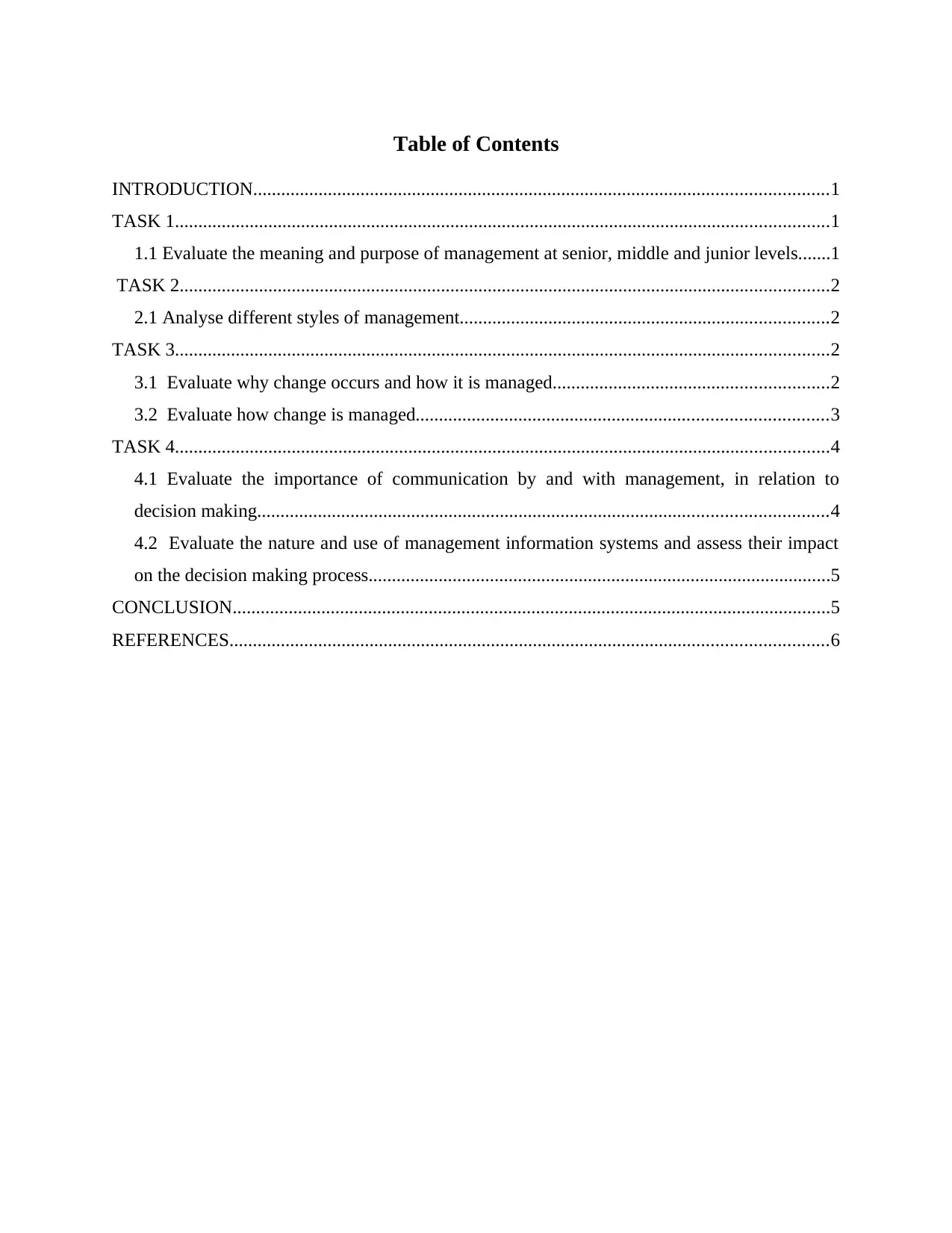
Table of Contents
INTRODUCTION...........................................................................................................................1
TASK 1............................................................................................................................................1
1.1 Evaluate the meaning and purpose of management at senior, middle and junior levels.......1
TASK 2...........................................................................................................................................2
2.1 Analyse different styles of management...............................................................................2
TASK 3............................................................................................................................................2
3.1 Evaluate why change occurs and how it is managed...........................................................2
3.2 Evaluate how change is managed........................................................................................3
TASK 4............................................................................................................................................4
4.1 Evaluate the importance of communication by and with management, in relation to
decision making..........................................................................................................................4
4.2 Evaluate the nature and use of management information systems and assess their impact
on the decision making process...................................................................................................5
CONCLUSION................................................................................................................................5
REFERENCES................................................................................................................................6
INTRODUCTION...........................................................................................................................1
TASK 1............................................................................................................................................1
1.1 Evaluate the meaning and purpose of management at senior, middle and junior levels.......1
TASK 2...........................................................................................................................................2
2.1 Analyse different styles of management...............................................................................2
TASK 3............................................................................................................................................2
3.1 Evaluate why change occurs and how it is managed...........................................................2
3.2 Evaluate how change is managed........................................................................................3
TASK 4............................................................................................................................................4
4.1 Evaluate the importance of communication by and with management, in relation to
decision making..........................................................................................................................4
4.2 Evaluate the nature and use of management information systems and assess their impact
on the decision making process...................................................................................................5
CONCLUSION................................................................................................................................5
REFERENCES................................................................................................................................6

⊘ This is a preview!⊘
Do you want full access?
Subscribe today to unlock all pages.

Trusted by 1+ million students worldwide
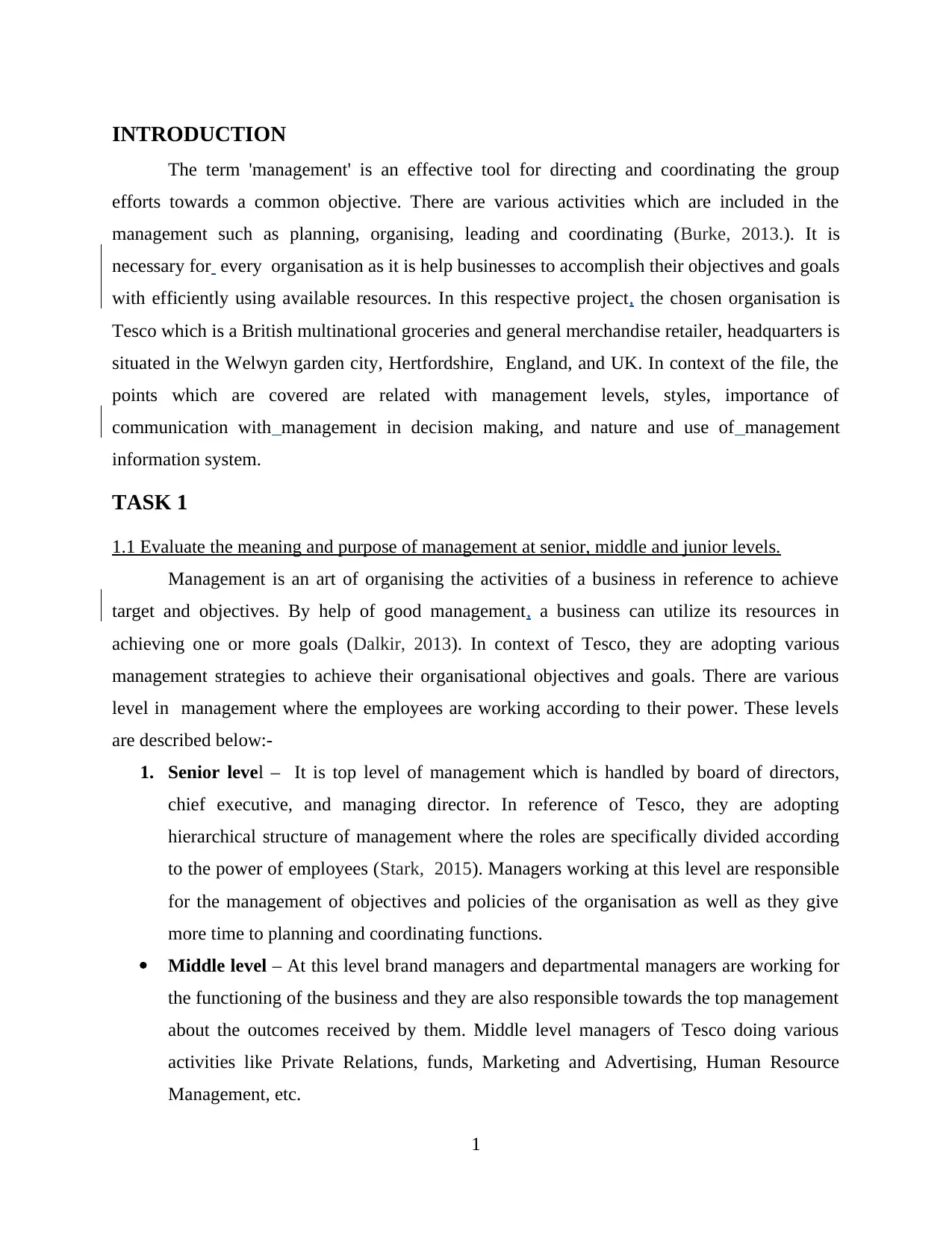
INTRODUCTION
The term 'management' is an effective tool for directing and coordinating the group
efforts towards a common objective. There are various activities which are included in the
management such as planning, organising, leading and coordinating (Burke, 2013.). It is
necessary for every organisation as it is help businesses to accomplish their objectives and goals
with efficiently using available resources. In this respective project, the chosen organisation is
Tesco which is a British multinational groceries and general merchandise retailer, headquarters is
situated in the Welwyn garden city, Hertfordshire, England, and UK. In context of the file, the
points which are covered are related with management levels, styles, importance of
communication with management in decision making, and nature and use of management
information system.
TASK 1
1.1 Evaluate the meaning and purpose of management at senior, middle and junior levels.
Management is an art of organising the activities of a business in reference to achieve
target and objectives. By help of good management, a business can utilize its resources in
achieving one or more goals (Dalkir, 2013). In context of Tesco, they are adopting various
management strategies to achieve their organisational objectives and goals. There are various
level in management where the employees are working according to their power. These levels
are described below:-
1. Senior level – It is top level of management which is handled by board of directors,
chief executive, and managing director. In reference of Tesco, they are adopting
hierarchical structure of management where the roles are specifically divided according
to the power of employees (Stark, 2015). Managers working at this level are responsible
for the management of objectives and policies of the organisation as well as they give
more time to planning and coordinating functions.
Middle level – At this level brand managers and departmental managers are working for
the functioning of the business and they are also responsible towards the top management
about the outcomes received by them. Middle level managers of Tesco doing various
activities like Private Relations, funds, Marketing and Advertising, Human Resource
Management, etc.
1
The term 'management' is an effective tool for directing and coordinating the group
efforts towards a common objective. There are various activities which are included in the
management such as planning, organising, leading and coordinating (Burke, 2013.). It is
necessary for every organisation as it is help businesses to accomplish their objectives and goals
with efficiently using available resources. In this respective project, the chosen organisation is
Tesco which is a British multinational groceries and general merchandise retailer, headquarters is
situated in the Welwyn garden city, Hertfordshire, England, and UK. In context of the file, the
points which are covered are related with management levels, styles, importance of
communication with management in decision making, and nature and use of management
information system.
TASK 1
1.1 Evaluate the meaning and purpose of management at senior, middle and junior levels.
Management is an art of organising the activities of a business in reference to achieve
target and objectives. By help of good management, a business can utilize its resources in
achieving one or more goals (Dalkir, 2013). In context of Tesco, they are adopting various
management strategies to achieve their organisational objectives and goals. There are various
level in management where the employees are working according to their power. These levels
are described below:-
1. Senior level – It is top level of management which is handled by board of directors,
chief executive, and managing director. In reference of Tesco, they are adopting
hierarchical structure of management where the roles are specifically divided according
to the power of employees (Stark, 2015). Managers working at this level are responsible
for the management of objectives and policies of the organisation as well as they give
more time to planning and coordinating functions.
Middle level – At this level brand managers and departmental managers are working for
the functioning of the business and they are also responsible towards the top management
about the outcomes received by them. Middle level managers of Tesco doing various
activities like Private Relations, funds, Marketing and Advertising, Human Resource
Management, etc.
1
Paraphrase This Document
Need a fresh take? Get an instant paraphrase of this document with our AI Paraphraser
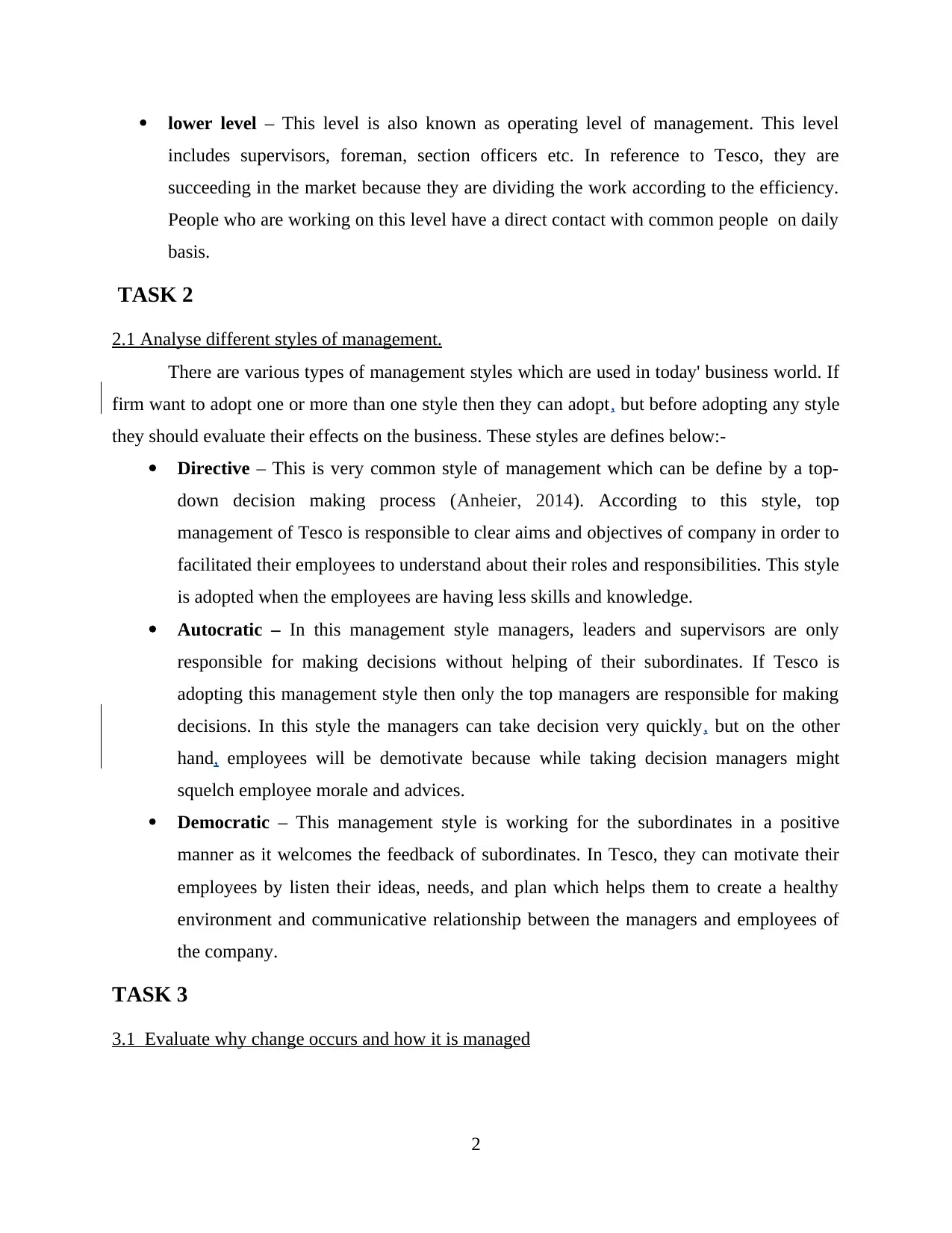
lower level – This level is also known as operating level of management. This level
includes supervisors, foreman, section officers etc. In reference to Tesco, they are
succeeding in the market because they are dividing the work according to the efficiency.
People who are working on this level have a direct contact with common people on daily
basis.
TASK 2
2.1 Analyse different styles of management.
There are various types of management styles which are used in today' business world. If
firm want to adopt one or more than one style then they can adopt, but before adopting any style
they should evaluate their effects on the business. These styles are defines below:-
Directive – This is very common style of management which can be define by a top-
down decision making process (Anheier, 2014). According to this style, top
management of Tesco is responsible to clear aims and objectives of company in order to
facilitated their employees to understand about their roles and responsibilities. This style
is adopted when the employees are having less skills and knowledge.
Autocratic – In this management style managers, leaders and supervisors are only
responsible for making decisions without helping of their subordinates. If Tesco is
adopting this management style then only the top managers are responsible for making
decisions. In this style the managers can take decision very quickly, but on the other
hand, employees will be demotivate because while taking decision managers might
squelch employee morale and advices.
Democratic – This management style is working for the subordinates in a positive
manner as it welcomes the feedback of subordinates. In Tesco, they can motivate their
employees by listen their ideas, needs, and plan which helps them to create a healthy
environment and communicative relationship between the managers and employees of
the company.
TASK 3
3.1 Evaluate why change occurs and how it is managed
2
includes supervisors, foreman, section officers etc. In reference to Tesco, they are
succeeding in the market because they are dividing the work according to the efficiency.
People who are working on this level have a direct contact with common people on daily
basis.
TASK 2
2.1 Analyse different styles of management.
There are various types of management styles which are used in today' business world. If
firm want to adopt one or more than one style then they can adopt, but before adopting any style
they should evaluate their effects on the business. These styles are defines below:-
Directive – This is very common style of management which can be define by a top-
down decision making process (Anheier, 2014). According to this style, top
management of Tesco is responsible to clear aims and objectives of company in order to
facilitated their employees to understand about their roles and responsibilities. This style
is adopted when the employees are having less skills and knowledge.
Autocratic – In this management style managers, leaders and supervisors are only
responsible for making decisions without helping of their subordinates. If Tesco is
adopting this management style then only the top managers are responsible for making
decisions. In this style the managers can take decision very quickly, but on the other
hand, employees will be demotivate because while taking decision managers might
squelch employee morale and advices.
Democratic – This management style is working for the subordinates in a positive
manner as it welcomes the feedback of subordinates. In Tesco, they can motivate their
employees by listen their ideas, needs, and plan which helps them to create a healthy
environment and communicative relationship between the managers and employees of
the company.
TASK 3
3.1 Evaluate why change occurs and how it is managed
2
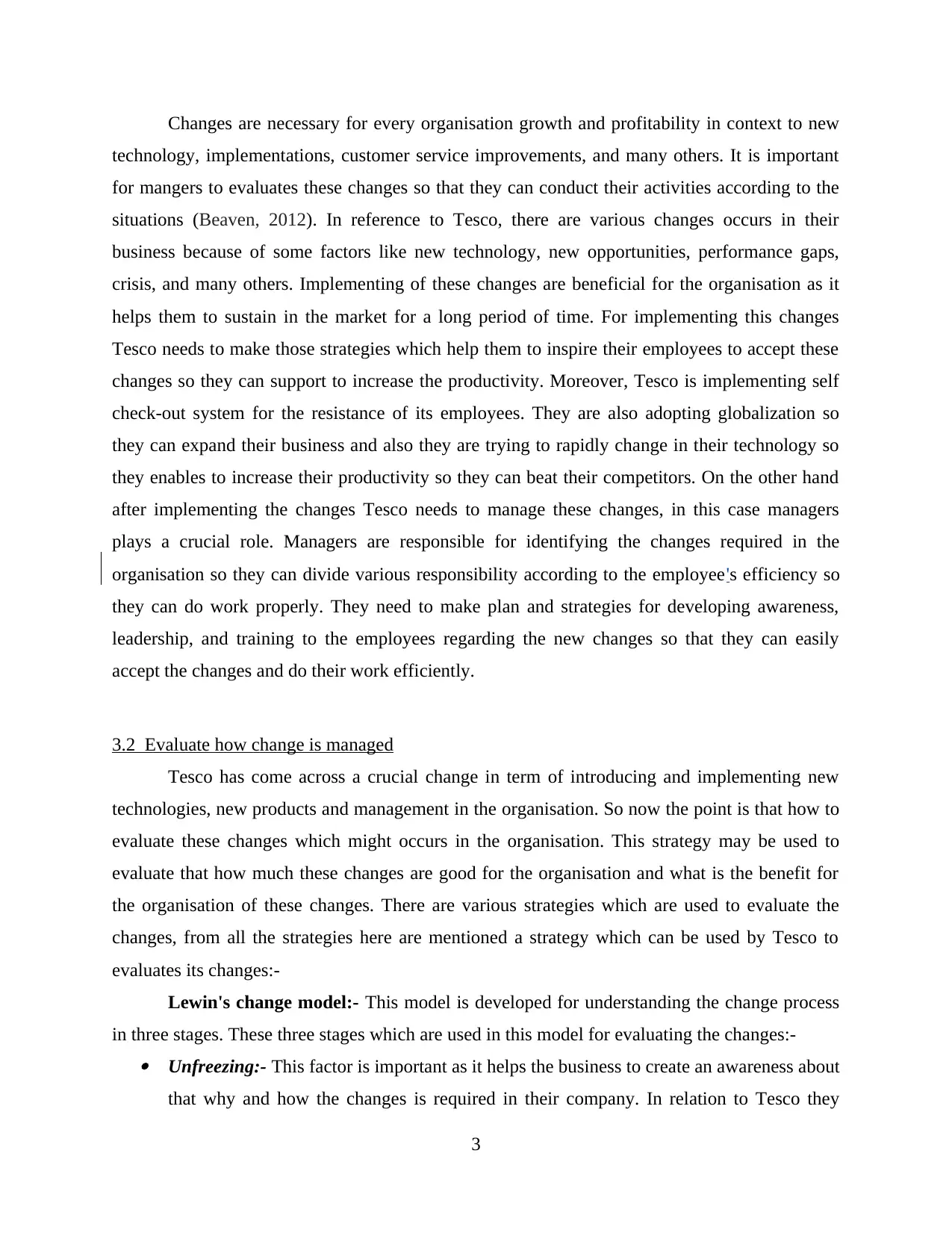
Changes are necessary for every organisation growth and profitability in context to new
technology, implementations, customer service improvements, and many others. It is important
for mangers to evaluates these changes so that they can conduct their activities according to the
situations (Beaven, 2012). In reference to Tesco, there are various changes occurs in their
business because of some factors like new technology, new opportunities, performance gaps,
crisis, and many others. Implementing of these changes are beneficial for the organisation as it
helps them to sustain in the market for a long period of time. For implementing this changes
Tesco needs to make those strategies which help them to inspire their employees to accept these
changes so they can support to increase the productivity. Moreover, Tesco is implementing self
check-out system for the resistance of its employees. They are also adopting globalization so
they can expand their business and also they are trying to rapidly change in their technology so
they enables to increase their productivity so they can beat their competitors. On the other hand
after implementing the changes Tesco needs to manage these changes, in this case managers
plays a crucial role. Managers are responsible for identifying the changes required in the
organisation so they can divide various responsibility according to the employee's efficiency so
they can do work properly. They need to make plan and strategies for developing awareness,
leadership, and training to the employees regarding the new changes so that they can easily
accept the changes and do their work efficiently.
3.2 Evaluate how change is managed
Tesco has come across a crucial change in term of introducing and implementing new
technologies, new products and management in the organisation. So now the point is that how to
evaluate these changes which might occurs in the organisation. This strategy may be used to
evaluate that how much these changes are good for the organisation and what is the benefit for
the organisation of these changes. There are various strategies which are used to evaluate the
changes, from all the strategies here are mentioned a strategy which can be used by Tesco to
evaluates its changes:-
Lewin's change model:- This model is developed for understanding the change process
in three stages. These three stages which are used in this model for evaluating the changes:- Unfreezing:- This factor is important as it helps the business to create an awareness about
that why and how the changes is required in their company. In relation to Tesco they
3
technology, implementations, customer service improvements, and many others. It is important
for mangers to evaluates these changes so that they can conduct their activities according to the
situations (Beaven, 2012). In reference to Tesco, there are various changes occurs in their
business because of some factors like new technology, new opportunities, performance gaps,
crisis, and many others. Implementing of these changes are beneficial for the organisation as it
helps them to sustain in the market for a long period of time. For implementing this changes
Tesco needs to make those strategies which help them to inspire their employees to accept these
changes so they can support to increase the productivity. Moreover, Tesco is implementing self
check-out system for the resistance of its employees. They are also adopting globalization so
they can expand their business and also they are trying to rapidly change in their technology so
they enables to increase their productivity so they can beat their competitors. On the other hand
after implementing the changes Tesco needs to manage these changes, in this case managers
plays a crucial role. Managers are responsible for identifying the changes required in the
organisation so they can divide various responsibility according to the employee's efficiency so
they can do work properly. They need to make plan and strategies for developing awareness,
leadership, and training to the employees regarding the new changes so that they can easily
accept the changes and do their work efficiently.
3.2 Evaluate how change is managed
Tesco has come across a crucial change in term of introducing and implementing new
technologies, new products and management in the organisation. So now the point is that how to
evaluate these changes which might occurs in the organisation. This strategy may be used to
evaluate that how much these changes are good for the organisation and what is the benefit for
the organisation of these changes. There are various strategies which are used to evaluate the
changes, from all the strategies here are mentioned a strategy which can be used by Tesco to
evaluates its changes:-
Lewin's change model:- This model is developed for understanding the change process
in three stages. These three stages which are used in this model for evaluating the changes:- Unfreezing:- This factor is important as it helps the business to create an awareness about
that why and how the changes is required in their company. In relation to Tesco they
3
⊘ This is a preview!⊘
Do you want full access?
Subscribe today to unlock all pages.

Trusted by 1+ million students worldwide
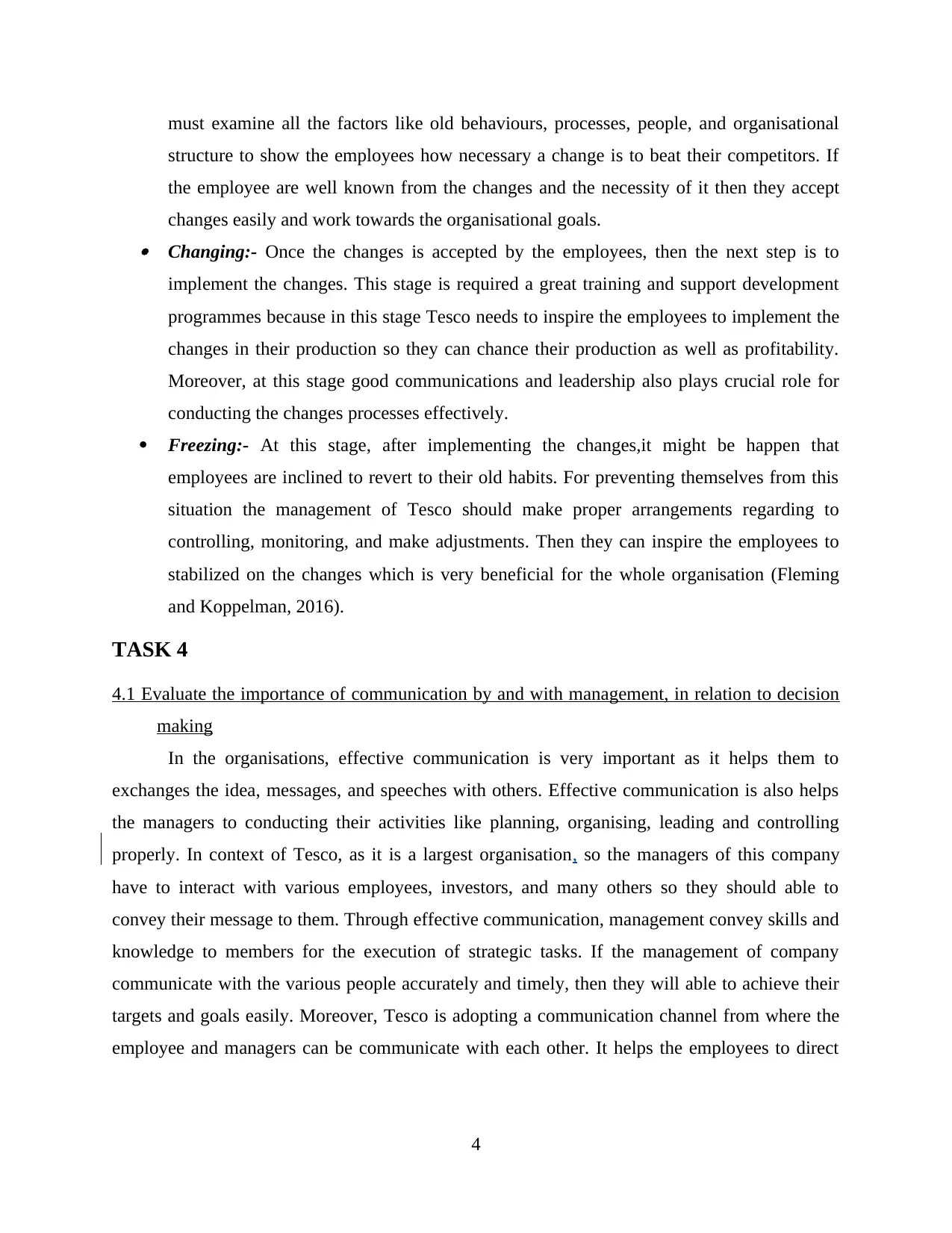
must examine all the factors like old behaviours, processes, people, and organisational
structure to show the employees how necessary a change is to beat their competitors. If
the employee are well known from the changes and the necessity of it then they accept
changes easily and work towards the organisational goals. Changing:- Once the changes is accepted by the employees, then the next step is to
implement the changes. This stage is required a great training and support development
programmes because in this stage Tesco needs to inspire the employees to implement the
changes in their production so they can chance their production as well as profitability.
Moreover, at this stage good communications and leadership also plays crucial role for
conducting the changes processes effectively.
Freezing:- At this stage, after implementing the changes,it might be happen that
employees are inclined to revert to their old habits. For preventing themselves from this
situation the management of Tesco should make proper arrangements regarding to
controlling, monitoring, and make adjustments. Then they can inspire the employees to
stabilized on the changes which is very beneficial for the whole organisation (Fleming
and Koppelman, 2016).
TASK 4
4.1 Evaluate the importance of communication by and with management, in relation to decision
making
In the organisations, effective communication is very important as it helps them to
exchanges the idea, messages, and speeches with others. Effective communication is also helps
the managers to conducting their activities like planning, organising, leading and controlling
properly. In context of Tesco, as it is a largest organisation, so the managers of this company
have to interact with various employees, investors, and many others so they should able to
convey their message to them. Through effective communication, management convey skills and
knowledge to members for the execution of strategic tasks. If the management of company
communicate with the various people accurately and timely, then they will able to achieve their
targets and goals easily. Moreover, Tesco is adopting a communication channel from where the
employee and managers can be communicate with each other. It helps the employees to direct
4
structure to show the employees how necessary a change is to beat their competitors. If
the employee are well known from the changes and the necessity of it then they accept
changes easily and work towards the organisational goals. Changing:- Once the changes is accepted by the employees, then the next step is to
implement the changes. This stage is required a great training and support development
programmes because in this stage Tesco needs to inspire the employees to implement the
changes in their production so they can chance their production as well as profitability.
Moreover, at this stage good communications and leadership also plays crucial role for
conducting the changes processes effectively.
Freezing:- At this stage, after implementing the changes,it might be happen that
employees are inclined to revert to their old habits. For preventing themselves from this
situation the management of Tesco should make proper arrangements regarding to
controlling, monitoring, and make adjustments. Then they can inspire the employees to
stabilized on the changes which is very beneficial for the whole organisation (Fleming
and Koppelman, 2016).
TASK 4
4.1 Evaluate the importance of communication by and with management, in relation to decision
making
In the organisations, effective communication is very important as it helps them to
exchanges the idea, messages, and speeches with others. Effective communication is also helps
the managers to conducting their activities like planning, organising, leading and controlling
properly. In context of Tesco, as it is a largest organisation, so the managers of this company
have to interact with various employees, investors, and many others so they should able to
convey their message to them. Through effective communication, management convey skills and
knowledge to members for the execution of strategic tasks. If the management of company
communicate with the various people accurately and timely, then they will able to achieve their
targets and goals easily. Moreover, Tesco is adopting a communication channel from where the
employee and managers can be communicate with each other. It helps the employees to direct
4
Paraphrase This Document
Need a fresh take? Get an instant paraphrase of this document with our AI Paraphraser
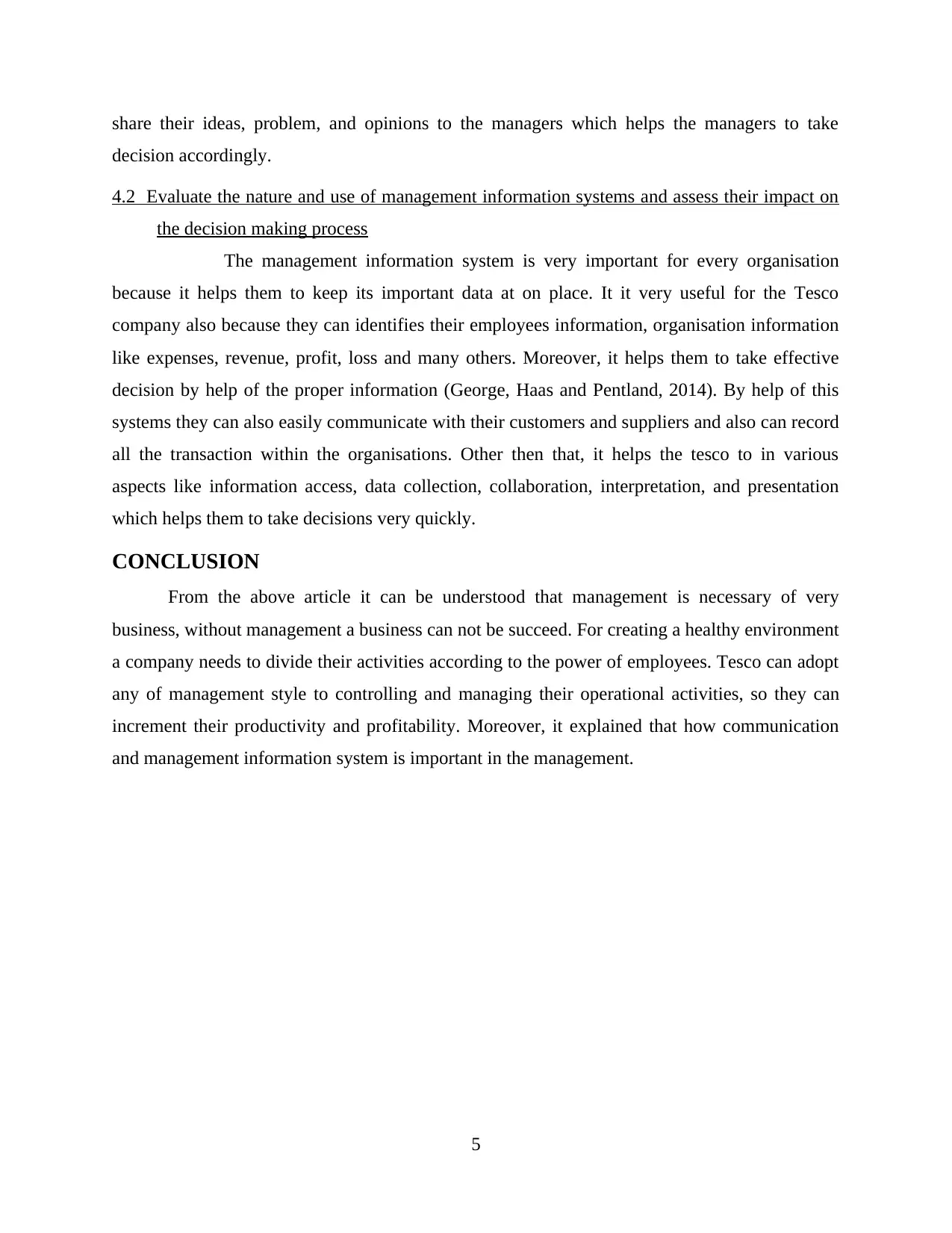
share their ideas, problem, and opinions to the managers which helps the managers to take
decision accordingly.
4.2 Evaluate the nature and use of management information systems and assess their impact on
the decision making process
The management information system is very important for every organisation
because it helps them to keep its important data at on place. It it very useful for the Tesco
company also because they can identifies their employees information, organisation information
like expenses, revenue, profit, loss and many others. Moreover, it helps them to take effective
decision by help of the proper information (George, Haas and Pentland, 2014). By help of this
systems they can also easily communicate with their customers and suppliers and also can record
all the transaction within the organisations. Other then that, it helps the tesco to in various
aspects like information access, data collection, collaboration, interpretation, and presentation
which helps them to take decisions very quickly.
CONCLUSION
From the above article it can be understood that management is necessary of very
business, without management a business can not be succeed. For creating a healthy environment
a company needs to divide their activities according to the power of employees. Tesco can adopt
any of management style to controlling and managing their operational activities, so they can
increment their productivity and profitability. Moreover, it explained that how communication
and management information system is important in the management.
5
decision accordingly.
4.2 Evaluate the nature and use of management information systems and assess their impact on
the decision making process
The management information system is very important for every organisation
because it helps them to keep its important data at on place. It it very useful for the Tesco
company also because they can identifies their employees information, organisation information
like expenses, revenue, profit, loss and many others. Moreover, it helps them to take effective
decision by help of the proper information (George, Haas and Pentland, 2014). By help of this
systems they can also easily communicate with their customers and suppliers and also can record
all the transaction within the organisations. Other then that, it helps the tesco to in various
aspects like information access, data collection, collaboration, interpretation, and presentation
which helps them to take decisions very quickly.
CONCLUSION
From the above article it can be understood that management is necessary of very
business, without management a business can not be succeed. For creating a healthy environment
a company needs to divide their activities according to the power of employees. Tesco can adopt
any of management style to controlling and managing their operational activities, so they can
increment their productivity and profitability. Moreover, it explained that how communication
and management information system is important in the management.
5
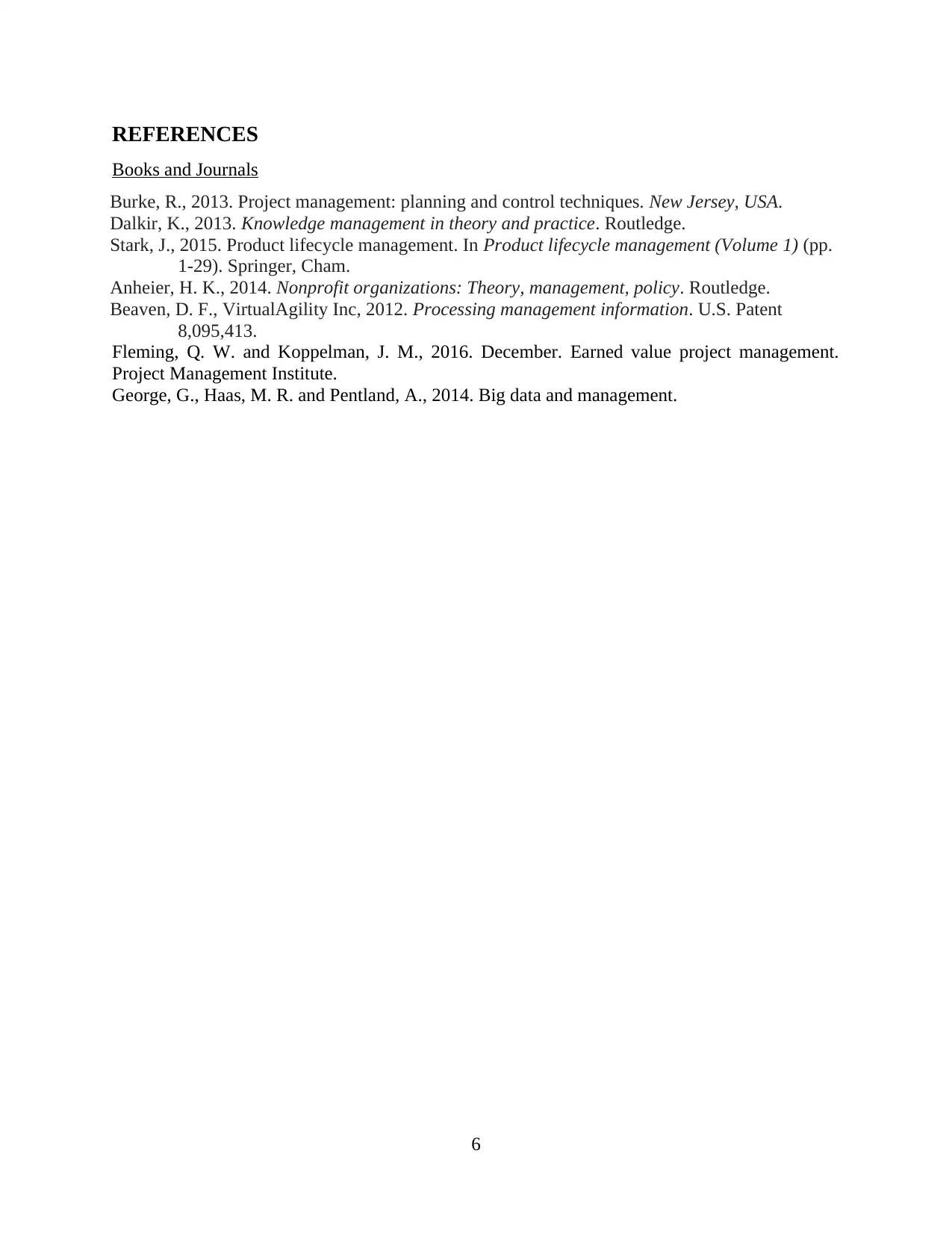
REFERENCES
Books and Journals
Burke, R., 2013. Project management: planning and control techniques. New Jersey, USA.
Dalkir, K., 2013. Knowledge management in theory and practice. Routledge.
Stark, J., 2015. Product lifecycle management. In Product lifecycle management (Volume 1) (pp.
1-29). Springer, Cham.
Anheier, H. K., 2014. Nonprofit organizations: Theory, management, policy. Routledge.
Beaven, D. F., VirtualAgility Inc, 2012. Processing management information. U.S. Patent
8,095,413.
Fleming, Q. W. and Koppelman, J. M., 2016. December. Earned value project management.
Project Management Institute.
George, G., Haas, M. R. and Pentland, A., 2014. Big data and management.
6
Books and Journals
Burke, R., 2013. Project management: planning and control techniques. New Jersey, USA.
Dalkir, K., 2013. Knowledge management in theory and practice. Routledge.
Stark, J., 2015. Product lifecycle management. In Product lifecycle management (Volume 1) (pp.
1-29). Springer, Cham.
Anheier, H. K., 2014. Nonprofit organizations: Theory, management, policy. Routledge.
Beaven, D. F., VirtualAgility Inc, 2012. Processing management information. U.S. Patent
8,095,413.
Fleming, Q. W. and Koppelman, J. M., 2016. December. Earned value project management.
Project Management Institute.
George, G., Haas, M. R. and Pentland, A., 2014. Big data and management.
6
⊘ This is a preview!⊘
Do you want full access?
Subscribe today to unlock all pages.

Trusted by 1+ million students worldwide
1 out of 9
Related Documents
Your All-in-One AI-Powered Toolkit for Academic Success.
+13062052269
info@desklib.com
Available 24*7 on WhatsApp / Email
![[object Object]](/_next/static/media/star-bottom.7253800d.svg)
Unlock your academic potential
Copyright © 2020–2025 A2Z Services. All Rights Reserved. Developed and managed by ZUCOL.





